If we are to get serious about making cycling a viable option for more Hamiltonians, we need to make some significant changes to our Cycling Master Plan.
By Ryan McGreal
Published June 22, 2015
Hamilton City Council approved the Shifting Gears Cycling Master Plan in 2009. That means it's good and ready for a five-year review.
Before Shifting Gears was presented to Council, the City had been spending as little as $300,000 a year on cycling, and in on more than one year spending nothing at all.
So the 2009 plan represented a significant improvement over the status quo: a 20-year strategy to spend $2.5 million a year building out a cycling network under the supervision of a dedicated project manager.
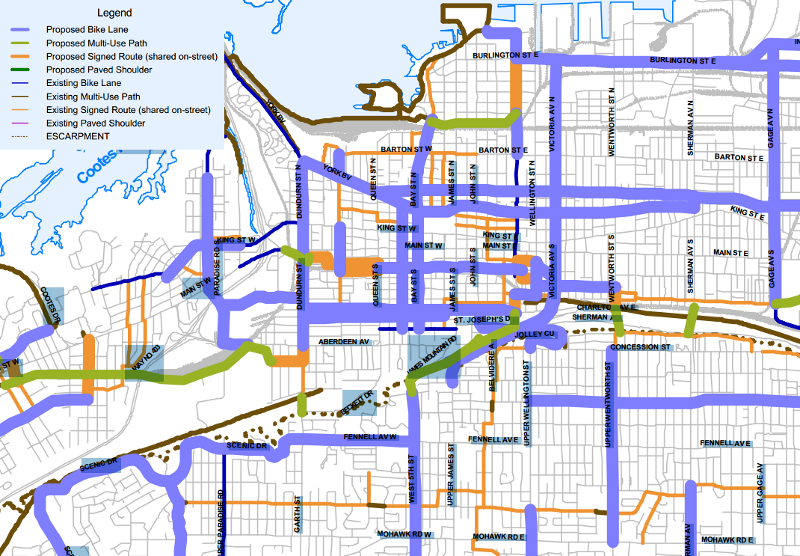
Detail from Shifting Gears bike route map
Unfortunately, the reality has not quite measured up to the promise. The actual rate of bike lane installation has been downright glacial, more than one project has been vetoed by the local ward councillor, and the infrastructure that has been installed have mostly been the kind of painted-line bike lanes that cities that are serious about cycling abandoned many years ago.
If we are to get serious about making cycling a viable option for more Hamiltonians, we need to make some significant changes to our Cycling Master Plan.
Specifically, we need to adopt a philosophy of routine accommodation, become a lot more proactive about engaging meaningfully with citizens, apply best practices to infrastructure design, obtain and apply better data, emphasize improving the connections between the various pieces of infrastructure, and focus on better wayfinding.
When Council received the Pedestrian Mobility Plan in November 2013, I was delighted to read that at the centre of the plan is the concept of routine accommodation. That means every time a street is built or rebuilt or receives maintenance, improvements for pedestrian accessibility will be included by default.
That is not how Shifting Gears works. Instead, our Cycling Master Plan is a specific network of streets that may receive cycling routes. If a street isn't already listed in the Cycling Master Plan, it is not even considered for possible infrastructure when it is being constructed or reconstructed.
Cyclists were excluded from the city's ill-fated bus-only lane on King Street because, as one manager explained, "the Cycling Master Plan does not propose bike lanes on King Street."
Likewise, cycling - and walking, for that matter - received no consideration in the recent reconstruction of the Beckett Drive escarpment access. Instead of adding a bike lane or sidewalk, the engineers widened the vehicle lanes and added a double yellow line buffer down the middle of the street.
And for the record, wider lanes actually encourage faster, more dangerous driving.
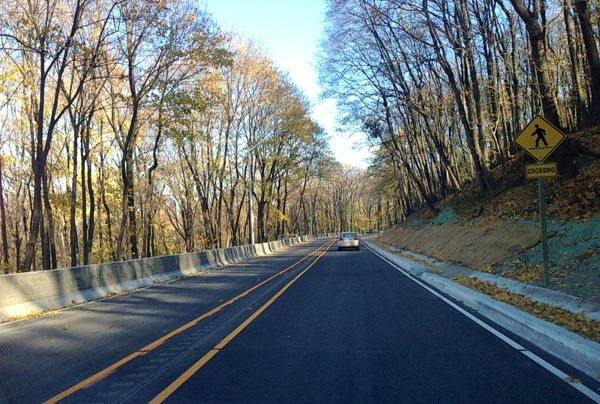
Beckett Drive reconstruction with no accommodation for walking or cycling
On top of that, ward councillors are allowed to exercise a veto over planned bike lanes in their wards, as Ward 6 Councillor Tom Jackson did in 2010 when he vetoed bike lanes on Queensdale Avenue.
As a result, the bike lanes on Queensdale Avenue in Ward 7 do not extend east across Upper Sherman.
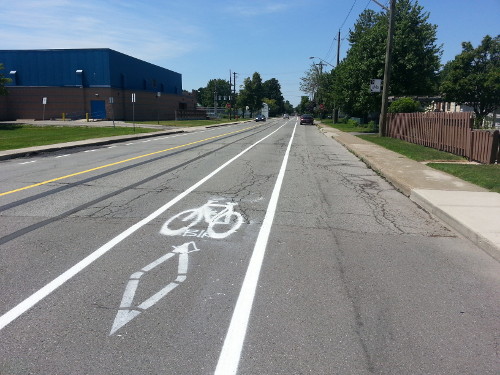
Queensdale bike lanes
In effect, Shifting Gears acts as a ceiling on the city's potential cycling network, not a floor. This needs to change: as long as it remains our cycling template, it will act as much to constrain the expansion of our cycling network as to facilitate it.
The City's track record on community engagement is decidedly mixed, but some groups do a better job than others. Unfortunately, the Cycling Office seems to be particularly immune to public feedback.
In the case of the Hunter Street bike lanes, volunteer associated with RTH spent more than a year trying to communicate with the office to advocate that the bike lanes be physically protected - with bollards or parallel parking - and continuous instead of stopping a couple of blocks away from the GO Station.
We received barely any response from the City and what we did receive was perfunctory. When the bike lanes were installed, they were neither physically protected nor continuous.
The only change that was made to the design was in response to business owners on Hunter Street East who objected to the loss of parking on their side of the street. The design was modified to retain the parking.
There is absolutely no reason not to physically protect the bike lanes on Hunter, and the office has never provided an explanation as to why the lanes are not protected.
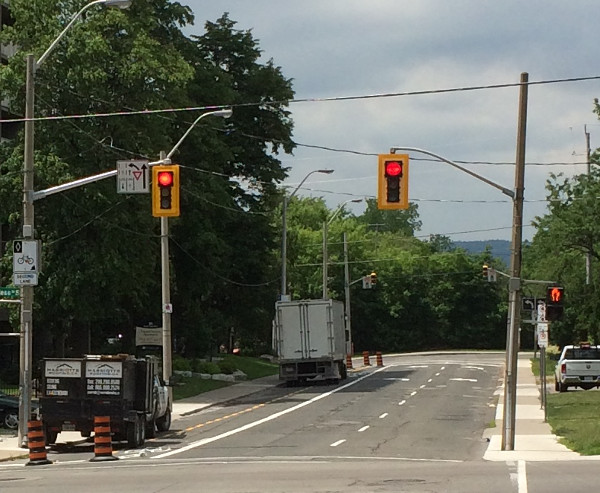
Vehicles blocking the Hunter Street bike lanes (Image Credit: Bob Berberick)
A more recent issue is the planned bike lane installations on Charlton Avenue West and Herkimer Street West. With no public consultation, the residents of Ward 2 were advised by construction notices that the City was about to install painted-line bike lanes that would run right in the "door zone" of paralled parked cars.
The Durand Neighbourhood Association pushed back on the design and struck a cycling committee to engage with the City on a better approach, including advocating for parking-protected bike lanes, which have proven to be much safer after their installation on several streets in New York City.
After months of delays and a fairly unproductive meeting, the City indicated that there are no firm timelines and the project might get bumped by other projects.
This feels downright passive-aggressive. A project manager trying to design cycling infrastructure should be delighted to learn that the community is excited and wants the best possible outcome. Instead, advocates are treated as just another problem to manage.
The research from cities around the world over the past four decades has clearly demonstrated that the only way to get a significant share of trips on bicycle is to build a protected, connected, continuous high-quality network of cycling routes that directly connect to important destinations.
All three criteria are essential for high use: the cycling route must be protected, connected and continuous. It's important to understand that for most potential cyclists, a bike route is only as usable as its least protected connection. That means a route that might otherwise be easy to ride becomes untenable if even a single block of it forces people to ride in mixed traffic.
Protected cycle tracks and neighbourhood greenways are the safest and best at attracting new riders.
Our cycling plan does not reflect this understanding of how to build a successful bike network. Shifting Gears identifies several types of cycling infrastructure: multi-use recreational trails, Reserved on-street bike lanes, signed bike routes (i.e. regular car lanes with bike sharrows painted on them), and rural paved shoulders.
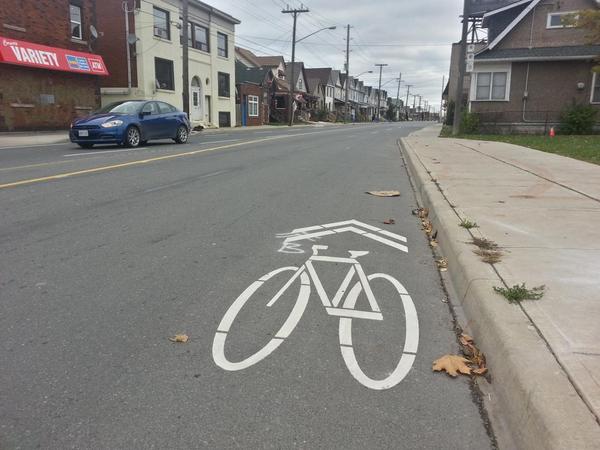
Signed bike route, AKA riding in mixed traffic, on Cannon east of Gage
Curiously, the plan makes brief mention of grade-separated and protected bike lanes but takes a dim view, citing higher capital costs, maintenance challenges and difficulty making left turns. It doesn't mention neighbourhood greenways at all, even though the original Cycling Master Plan in 1999 discussed them.
It's no coincidence that the only protected bike lanes in the city, the Cannon Street Cycle Track, was approved directly by Council after a massive public campaign and designed by an outside transportation consultant.
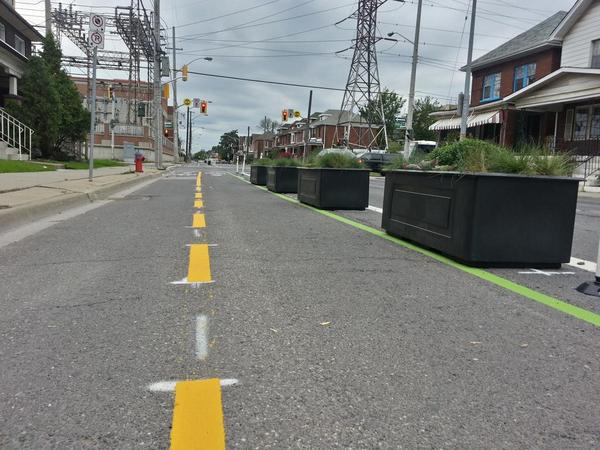
Cannon Street Cycle Track
When City staff undertook to extend cycling infrastructure beyond the eastern and western boundaries of the Cannon Cycle Track, they reverted to the painted lines that characterize most on-street cycling infrastructure in Hamilton.
On York Boulevard west of Hess, the bike lanes at least have a space buffer from the adjacent vehicle traffic lane. However, we know that in the absence of physical protection, most people will not feel safe riding on those lanes.
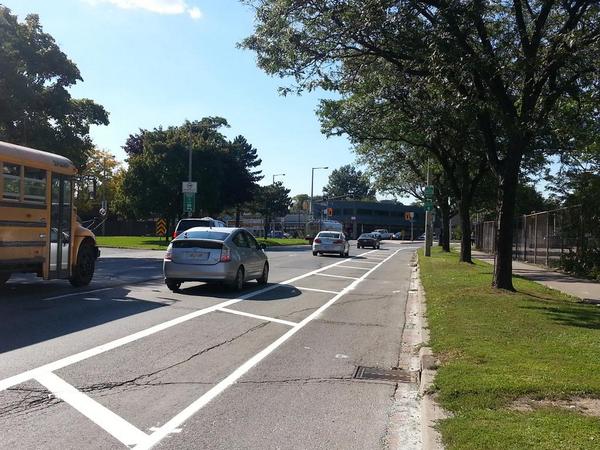
Buffered bike lane on York Boulevard
East of Sherman, there is no cycling infrastructure for two blocks and, indeed, no apparent way for an eastbound cyclist to cross Sherman at all. A bare-bones painted lane appears past Lottridge and runs to just before Gage, where it ends abruptly.
Likewise, the Hunter Street Bike Lanes are not physically protected from automobile traffic - aside from a few knockdown sticks just east of Park Street, which were installed a few months later on the request of the local Councillor.
This is despite the fact that the two-way bike lane is wide enough to run a truck with a snow plow - even along the short section where there are knockdown sticks in place.
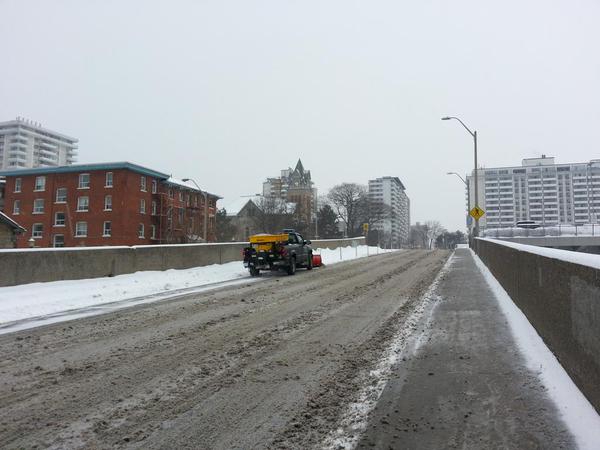
Truck plowing Hunter Street Bike Lanes
One predictable result of the lack of physical protection on Hunter Street is that cycling uptake has not been very significant, especially compared to the protected cycle track on Cannon Street.
Between 2013 and 2014, the number of weekly eastbound trips on Hunter increased from 35 (since Hunter is one-way westbound) to around 300. Meanwhile, the number of westbound trips increased only modestly from around 300 to around 400.
In contrast, bicycle traffic on Cannon increased from nearly zero before the cycle track was installed to 250-400 a day within a few weeks.
This is clear, local evidence that protected cycle tracks attract many more riders than unprotected painted bike lanes; but the city's Cycling Office remains deeply reluctant to do what we know works.
The state of the art in cycling infrastructure has changed pretty significantly in the past several years as best practices emerge from cities that are ahead of us in designing and building their cycling networks.
By ignoring that best practice research, we are effectively wasting money by building inferior bike lanes that are less safe and attract fewer people to use them.
Not incidentally, we don't know how many bicycle trips are happening on Cannon Street currently, because there has not been a bike counter on Cannon since counts were taken last fall. This is despite the fact that the Cannon Cycle Track installation came in $160,000 below its budget.
The lack of data collection - before or after - is endemic in Hamilton's cycling network. The data cited above for Hunter Street was collected at different locations in the before and after stages and should be taken with a grain of salt, although the order of magnitude is likely correct.
But cycling data is generally lacking and it does not appear that the data we do have is being used to drive policy. As a result, politicians are inclined to make decisions based on anecdote and prejudice - and that approach is unlikely to lead to the best outcomes.
More generally, the city needs to start applying a data-driven analysis to its transportation infrastructure priorities. Our cycling-averse fiscal scolds claim we can't afford to spend more money on cycling infrastructure, but the economics change dramatically once you factor in an actual cost-benefit analysis.
A recent economics paper comparing the cost of cars and bicycles in Copenhagen noted that the city applies cost-benefit analysis, including externalities, when making transport policy decisions.
[In Copenhagen] a cost–benefit analysis (CBA) methodology was developed and subsequently refined to assess infrastructure projects with regard to transport costs, security, comfort, branding effects & tourism, transport times and health. The analysis revealed that cycling entails considerably lower costs to society than car driving, and is now used for assessments and the implementation of infrastructural change in favour of the bike.
On top of the various costs of car ownership, the total cost of driving includes: damage, injury, lost productivity and early death related to traffic collisions; illness, hospitalization and early death from air pollution; use of road space and congestion; damage and deterioration of roadway infrastructure due to wear and tear; the poor health outcomes associated with automobile commuting; health issues due to traffic noise; and release of greenhouse gases contributing to climate change.
The paper found that the total cost per kilometre of driving - including externalized costs borne by society as a whole - is €0.50 ($0.70 Cdn) for a kilometre of driving, compared to €0.08 ($0.11 Cdn) for a kilometre of cycling.
Looking at the social cost-benefit, each kilometre driven costs society €0.15 ($0.21 Cdn), whereas each kilometre cycled actually represents a gain to society of €0.16 ($0.22 Cdn).
According to Stefan Gossling, the lead author, "If we want people to cycle, then we have to change our approach towards urban infrastructure. Cyclists will only cycle [in large numbers] when they feel physically safe and when it's fast, which means they need to be physically separated from cars."
Closer to home, the Region of Waterloo has calculated that each one-percent mode shift away from driving will save the region $30 million in infrastructure lifecycle costs.
Hamilton has not conducted this kind of total cost-benefit analysis. We approve road construction projects costing many millions of dollars with scarcely any debate, but then boil the ocean over even modest improvements to our cycling network. If we want better policy decisions, we need to supply council with better data.
Recently, the Google corporation proposed a high-quality network of protected cycle tracks for Silicon Valley to get more people commuting on bike. They took the innovative approach of representing the quality of the network as a stress map reflecting how stressful the various parts of a given route will be:
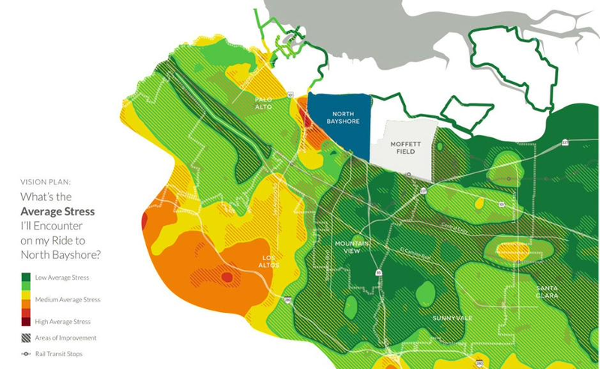
Google cycling network stress map
I would love to see this approach taken with Hamilton's cycling network. We have quite a few pieces of dedicated cycling infrastructure, ranging from poor to very good, but they are for the most part fragmentary with poor or no connections between them.
At every point where the stress of trying to navigate a trip on bike gets high, the number of people who might potentially choose to ride a bike plummets.
An excellent case in point is the intersection of Dundurn Street North and York Boulevard. There are bike lanes on Dundurn, on York west of Dundurn, and on York east of Dundurn, but there is no obvious way to get from one street onto the other.
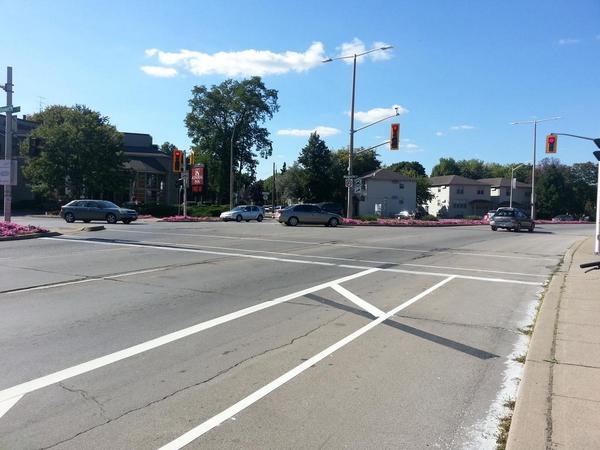
York Boulevard bike lane at Dundurn
Between the lack of physical protection from traffic and the absence of a path through the intersection onto Dundurn, this bike lane is a huge missed opportunity to make cycling accessible to a lot more people.
The lack of connections between pieces of cycling infrastructure combines with the relative lack of signage and markings to help people find their way.
The Escarpment Trail runs through Mohawk Sports Park, crosses Limeridge Road East and down to the parking lot on Arbour Road near Mountain Brow Boulevard, across from Albion Falls. A helpful signpost at the parking lot points to several nearby trails.

Trail signs near Albion Falls
If you continue south on Arbour Road, it takes to you a bridge across the Red Hill Valley Parkway, but a sign on that road indicates that it is not a through route. Assuming you know to ignore the sign and cross the freeway, a paved trail runs down to Stone Church Road next to Arbour Road.
On the south side of Stone Church, the cross street changes to Anchor Road. Heading west, there is a paved pathway running alongside Stone Church:
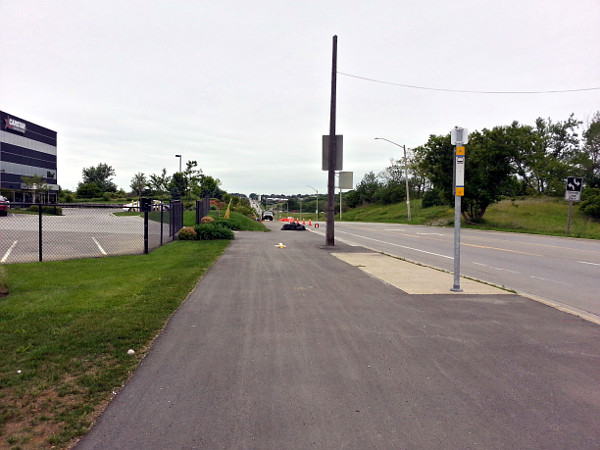
Paved pathway on Stone Church from Anchor Road to Dartnall Road
That path extends a block to Dartnall Road, and if you cross Dartnall you can pick up the Chippewa Trail, which runs all the way to Caledonia.
Unfortunately, there are no signs or markings on the path to indicate either that it is for cycling or that it connects to any trails. There is hardly any consideration given to wayfinding, i.e. the ability for a person on a bike to figure out where they are and where they have to go.
This is a common theme. There is an off-street two-way cycle track on Longwood Road running between Aberdeen Avenue and Frid Street, but there are no signs or markings anywhere along the route to inform people that it exists.
Even worse, the track has guy wires anchored to the ground right in the middle of it. Recently the City "fixed" the issue by mounting yellow-and-black diagonal hazard signs in front of them.
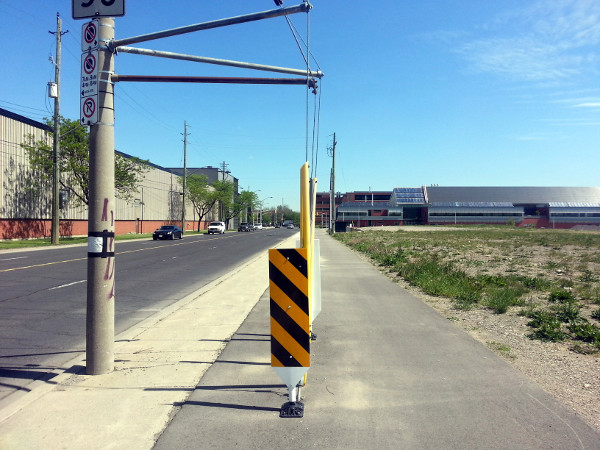
City fix for guy wires blocking Longwood Road South cycle track
Frankly, this is appalling.
Every city is different and has unique challenges, but an array of cities around the world with a wide variety of geographies, climates and demographics have all proven that with the right policy, any city can become a great place to get around on a bike.
It is past time for Hamilton to start learning from what other cities are already doing right and applying those practices here instead of falling back on older, inferior designs or, worse, reinventing the wheel (badly).
Each project we build is a one-time chance to get it right, because we will be stuck with it for years to come. Even worse, new cycling infrastructure that is designed badly will fail to attract cyclists, which undercuts support for additional projects.
As long as we continue not to aim for excellence, we are setting our cycling network up for failure - and during a time when interest in and enthusiasm for cycling is exploding around the industrialized world.
We have an easy opportunity to do what a few pioneering European cities did in the 1970s and permanently change the mix of how Hamiltonians choose to get around - and we get to do it with the full benefit of hindsight after 40 years of trial and error in those places.
Let's prove the case, aim for excellence, get it right and make a real and sustained improvement to our city's quality of life.
By Pxtl (registered) - website | Posted June 22, 2015 at 11:23:31
Recently the City "fixed" the issue by mounting yellow-and-black diagonal hazard signs in front of them.
I'm pretty sure those are gone now, actually. They came down soon after the article on the subject.
And yes, I'm a cyclists and I'm frequently disappointed in how disconnected our great cycling routes are. I go from Westdale to HGH, and the gaps are absurd - there's a bike lane north of Barton on Victoria, but it doesn't connect to the Cannon track. There's no good place to turn south anywhere west of James.
What impresses me is that the cyclists of this city are generally producing realistic, pragmatic suggestions for cycling improvements. I mean, nobody is saying "turn King into a woonerf", we're talking about useful, reasonable plans for cycling infrastructure with real-world traffic counts in mind.
And yet the cycling office seems to ignore us.
I mean, look at this map:
https://www.google.com/maps/d/edit?mid=z...
There is so much fantastic low-hanging fruit in there.
By Bollardo (anonymous) | Posted June 22, 2015 at 11:43:19
We should have a priority based policy: trees over planters every time, planters over bollards every time, bollards over paint every time, etc. Wherever possible.
By debuzz (anonymous) | Posted June 22, 2015 at 11:53:34
And don't forget nothing got built in 2013 because the one manager who looks after bike lanes was pulled off to design the bus only lane. And we all know how that turned out...
By Pxtl (registered) - website | Posted June 22, 2015 at 12:09:23 in reply to Comment 112390
That is not a ringing endorsement of his skills, because whether or not you support the idea of a bus lane on king, one has to admit that the one we got wasn't designed terribly well.
By eastmount (anonymous) | Posted June 22, 2015 at 12:12:01
There are currently no bike lanes on Queensdale at all. After the street was reconstructed last year the bike lanes between Upper Wentworth and Upper Wellington were not put back.
By highwater (registered) | Posted June 22, 2015 at 12:18:15 in reply to Comment 112392
Isn't that the street where Cllr. Jackson personally put the kibosh on bike lanes?
By eastmount (anonymous) | Posted June 22, 2015 at 12:24:01 in reply to Comment 112393
Jackson kiboshed the section in his ward, Upper Ottawa to Upper Sherman. The only section that had lanes was Wentworth to Wellington. Queensdale from Upper Sherman to Upper Wellington has been rebuilt over the past 2 or 3 years.
By ergopepsi (registered) | Posted June 22, 2015 at 12:36:13
I honestly didn't know that lane on Longwood was an actual bike lane - I felt guilty riding on it! Looks like many might feel the same way up on Stonechurch. You would think that a bit of paint wouldn't cost too much to buy and apply? It almost seems as if the city doesn't want to draw attention to the fact that those are bikes lanes.
As for the painted lanes on the sides of the road, sandwiched between moving cars and the curb, I absolutely agree that they do not encourage cycling. The more I have thought about it I wonder how it ever seemed reasonable to do that. By painting those lanes the city is inviting cyclists (children, parents, human beings) to ride on them. It's like building a bridge that you know is dangerous and inviting people to cross it. I think there should be a policy of either building the lane protected (parked cars or off-road) or not building it at all. There are so many places where this can be done. Dundurn should flip the lanes and the parking - it is the most dangerous one I have ridden on. York bouleveard has so much space off road. Why not a trail right beside the walking trail?
Right now I do not allow my bike riding son to use virtually any of the lanes that exist. I tell him to ride on the sidewalk on busy streets and hop off or stop if he approaches a pedestrian. It's a shame because it doesn't have to be this way.
By Simon (registered) - website | Posted June 22, 2015 at 13:44:23
Same thing happened with the reconstruction of Concession Street. Not on the Cycling Master Plan = No Bike Lane For You. At least there are no major employers or businesses that local buyers would frequent on Concession Street.
By kevlahan (registered) | Posted June 22, 2015 at 14:18:00 in reply to Comment 112397
That's a bit bizarre: back in April the DNA cycling committee was told that "currently a Cannon extension and Queensdale project are priorities" over the Herkimer/Charlton bike lanes that had originally been scheduled for implementation in Fall 2014.
Is there another portion of Queensdale cycle lane that is being implemented?
If not, why would a cycle lane project that the ward councillor hasn't yet decided to support have overtaken cycle lanes that have a huge amount of public support and active interest from the ward councillor and residents ... to make them even better?
By This Too Shall Pass (anonymous) | Posted June 22, 2015 at 14:56:09
It's almost as if those that run this city are hoping that if they ignore the issue of bike infrastructure long enough it will all blow over and people will stop asking for it.
By kevlahan (registered) | Posted June 22, 2015 at 16:31:55 in reply to Comment 112401
We've been through this many times whenever the subject of cycling comes up.
Any reasonable levels of fees would cost more to collect than they would bring in (environmental fees for cyclists? Really!?). For example, it costs $12 per year to license a moped; bicycles would presumably be even cheaper.
Every person who cycles instead of drives is very obviously decreasing pollution, decreasing the overall rate of serious accidents, and decreasing wear and tear on the roads. They also decrease congestion for motorists. Is that something you want to discourage by adding punitive fees? Should pedestrians be licensed and forced to pass "walking tests" in order to be allowed to walk on the sidewalks and cross the street?
And most motorists do not stop at stop signs. Try hanging around a stop sign for a while and watch. Not to mention all the other traffic laws they regularly break, especially speed limits (fully half the drives on Hunter were measured to have broken the speed limit). No one says we shouldn't spend anything on facilities for motorists until motorists stop breaking the laws. Not to mention that the vast majority of adult cyclists are already licensed drivers ...
Such suggestions are obviously just punitive, made by people annoyed at having to deal with bikes on the road and "losing" space to cyclists.
Comment edited by kevlahan on 2015-06-22 16:51:14
By Pxtl (registered) - website | Posted June 22, 2015 at 16:32:32 in reply to Comment 112401
Cyclists need to pay licensing, ownership, safety inspection, environment fees (rubber tires!) like car owners
The overhead in running such programs would completely dwarf any positive outcome of it.
So, should pedestrians pay licensing and have their shoes inspected and pay environmental fees on them?
By KevinLove (registered) | Posted June 22, 2015 at 17:00:30
Ditto for the new GO Station on James North. Metrolinx designed bike parking and a SoBi station at the main James Street entrance. But the short strech of James from the Cannon cycle path to the station is getting zip, zero, nada.
It is the fault of Metrolinx, of course. They failed to plan their train station far enough in advance to get it into the 2009 Cycling Master Plan.
By John S (anonymous) | Posted June 22, 2015 at 17:15:29
Will comments that were collected during the April Transportation Summit themed "Going for Gold" be forwarded and considered for the Shifting Gears review?
By Dylan (registered) | Posted June 22, 2015 at 17:26:35
What's wrong with Beckett Drive? There's a sign that politely asks you not to hit pedestrians that are forced onto the road and everything!
By fmurray (registered) | Posted June 22, 2015 at 20:07:37
Thanks, Ryan.
That map is so disjointed it can't be taken seriously. The east-west routes are inadequate in order to avoid doing anything to disturb auto traffic on King and Main. And the north-south routes: Nothing between Victoria and Gage!
I agree - routine accommodation is the only solution to have cycling infrastructure that makes some sense.
By jason (registered) | Posted June 22, 2015 at 20:29:09
Great piece Ryan. I've stopped sending in any requests or suggestions to the cycling office. Total waste of time.
Amazing that with our beautiful west harbour we have NO cycling routes connecting it south to the city.
All these disgusting, giant one way expressways like Wellington, Victoria with no traffic at all, and the city just keeps repaving and re-striping these streets as if we're Manhattan.
Might be time for a public protest at a council meeting or in front of city hall.
By jason (registered) | Posted June 22, 2015 at 20:31:34
Maybe someday city hall will figure out how to do this. Looks like a veeeeery tricky paint job
By Simon (registered) - website | Posted June 23, 2015 at 09:13:04
Thing is, its not just about bike lanes.
Bike lanes should be seen as just a part of the overall street scape.
There is zero initiative to do anything besides status quo. Concession Street is a prime example of a huge missed opportunity - but there are all kinds of smaller examples. One is Inverness Avenue that runs between Upper James and Upper Wellington. It was just resurfaced within the last couple years. This is a massively overbuilt road - easily 4 lanes wide for no reason at all. It passes a school with a crossing guard.
Instead of simply narrowing the road to a normal 2 lane residential street by adding grassed boulevards, steet trees and a bike lane to make this into a really attractive community boulevard - they just re-paved it the same as it was.
The costs for simple aesthetic upgrades like this are minimal - but have a huge effect on the livability of public spaces.
I think a real road block is public works staff who often decide the details on projects like these.
They see anything aesthetic as nothing more than maintenance work for the City - so the default attitude is pave it and we don't have to do anything.
Comment edited by Simon on 2015-06-23 09:20:21
By Brandon (registered) | Posted June 23, 2015 at 09:34:56 in reply to Comment 112410
Can't be done. Where do the cars go?
By StephenBarath (registered) | Posted June 23, 2015 at 10:02:07 in reply to Comment 112411
Someone else can probably tell us more certainly than I can, but I expect that your idea for Inverness would mean less maintenance costs in the long run. The municipal government doesn't maintain boulevard grass; bike lanes require repaving less frequently than car lanes; and street trees have a positive return on investment. It might have been a somewhat higher capital cost to narrow the road and install these things, but they would actually reduce our future liability in maintenance costs.
By AnjoMan (registered) | Posted June 23, 2015 at 11:12:33
I just want to say that the title of this piece is itself a beautiful work of art.
By AnjoMan (registered) | Posted June 23, 2015 at 11:22:47 in reply to Comment 112401
Cyclists need to pay licensing, ownership, safety inspection, environment fees (rubber tires!)
Can you give even one good reason why these measures are necessary for cycling? What problem do they correct?
By KevinLove (registered) | Posted June 23, 2015 at 12:54:30 in reply to Comment 112409
Or you could show up at City Hall the first Wednesday of each month at 5:30 PM and tell City staff to their face what you think of their latest cycling proposals. Frequently the Councilor liaison will also be present so you can also tell a member of City Council to their face what you think.
By ergopepsi (registered) | Posted June 23, 2015 at 13:41:20 in reply to Comment 112416
I think this persons attitude is one that needs just as much attention as the lack of cycling infrastructure and city councils aversion to the subject. Cyclists are seen by many - and probably most at city hall - as an annoyance that should be gotten rid of. If that attitude can be changed I think the largest battle would be won. It is this kind of emotional resistance that makes even the smallest improvement almost impossible to gain.
How do you win over those who think cyclists are annoying losers that run red lights and stop signs and make us all late for work? Not sure. One thing might be to move the cycling lanes out of traffic. It would a)remove the cyclists from the car drivers field of vision and b) be safer for the cyclist. Take a look at the image Ryan posted in this comments section of Hess St. Perhaps areas like this could have the bike lane next to the sidewalk with the 16 foot hashed lines between it and the car lane. Many little improvements like that could go a long way.
Also, I think current cyclists should really try to be good ambassadors for cycling in their day to day. I have seen grown sensible looking adults cycling at speed on sidewalks weaving around pedestrians - and yes blowing through stop signs. Just yesterday I saw a cyclist riding in the middle of the road down Dundurn with a trail of cars following behind her. The bike lane was right there but she wasn't using it. These actions only serve to increase anger towards cyclists and re-enforce the arguments against cycling in general.
By jason (registered) | Posted June 23, 2015 at 17:42:33 in reply to Comment 112418
of course it has a right turn lane. Just like James N has one into a banquet hall. Heaven forbid cars make a right hand turn out of the centre lane like every other city on planet earth.
By Dylan (registered) | Posted June 23, 2015 at 18:23:38 in reply to Comment 112425
So cyclists don't pay municipal, provincial, and federal taxes? Automobile lanes are more than twice the size of a bike lane, require more maintenance, and there are infinitely more of them than bike infrastructure. It would be more accurate to say that vehicle owners need to "pay their fair share" than it would to ask cyclists to pay more.
By Banker (anonymous) | Posted June 23, 2015 at 19:05:03 in reply to Comment 112426
By Pxtl (registered) - website | Posted June 23, 2015 at 19:45:08 in reply to Comment 112429
Even the CAA, which is obviously heavily biased for drivers, admits that automobile-related fees do not cover the complete costs of the roadway - there is significant subsidy from the general funds of the government, far more than the narrow unprotected strips of urban land afforded to cyclists.
Pedestrians don't pay gas tax either, should we eliminate sidewalks?
By Dylan (registered) | Posted June 23, 2015 at 20:41:42 in reply to Comment 112429
Why are you citing HST as an exclusive tax on cars and their parts? Maybe I'm ignorant on the subject, but I could have sworn I paid HST on the bike I bought last summer.
With exception to the gas tax which is, in theory, designed to contribute to infrastructure and public transit that benefit the very same people paying it, the fees for driving are nominal and fair, if not too lean. Drivers choose to transit using the least cost effective, highest polluting, and least personally healthy way to travel of their own accord (and in part because other infrastructure is inadequate). Drivers place a strain on our system due to affects on the environment and the health of the population. Cycling on the other hand does the opposite, and youre going to grip that we're not charging little Jimmy's $100 a year so he can rid his bike to school?
By KevinLove (registered) | Posted June 23, 2015 at 21:33:10 in reply to Comment 112420
Just yesterday I saw a cyclist riding in the middle of the road down Dundurn with a trail of cars following behind her. The bike lane was right there but she wasn't using it.
Perhaps because she did not have a death wish? The most dangerous place in the road to ride a bike on Dundurn is in the bike lane. Why? Because our City staff put the bike lane in the door zone.
Comment edited by KevinLove on 2015-06-23 21:33:24
By KevinLove (registered) | Posted June 23, 2015 at 21:40:20 in reply to Comment 112431
And let's not forget how in 2009 the governments of Canada and Ontario spent $13.7 billion buying shares of bankrupt bicycle companies. Oh, wait...
Comment edited by KevinLove on 2015-06-23 21:41:47
By Cultosaurus (registered) | Posted June 23, 2015 at 21:45:14 in reply to Comment 112425
Troll be trollin'
By Banker (anonymous) | Posted June 23, 2015 at 22:50:48 in reply to Comment 112435
By Banker (anonymous) | Posted June 23, 2015 at 22:52:52 in reply to Comment 112432
By moylek (registered) - website | Posted June 24, 2015 at 07:12:14 in reply to Comment 112402
And most motorists do not stop at stop signs. Try hanging around a stop sign for a while and watch.
You and I both bike through West Hamilton pretty much every day. Is it really your impression that drivers and cyclists run stop signs in proportional numbers? I feel certain that I see cyclists do it more often and more flagrantly both in relative and absolute numbers - though, yes, with far less potential danger to others.
More specifically and significantly, how often do you see drivers just blow through a four-way when other people are waiting? I see it on Sterling alone at least once a week, sometimes more than once a day.
Not to give to much credence to the person to whom you are responding, but we're not going to win people over by contradicting these sort of plainly visible breaches of law and etiquette.
That said, I'm seeing the proportion of scoff-law cyclists go down as more and more people take to utility cycling and cycle like grown-ups (signalling; stopping; waiting their turn).
Comment edited by moylek on 2015-06-24 07:39:12
By jason (registered) | Posted June 24, 2015 at 08:10:25 in reply to Comment 112434
I almost got killed using that bike lane yesterday. It's ultra narrow and horrendously bumpy and the driving lane is wide and fast. I hit a pot hole while riding a Sobi bike and skidded towards the curb where I then started wobbling along a driveway ramp that was several inches buckled above the road. I thought for sure I was going down into the live lane but managed to gain control and get my feet down. Bike lanes are quite useless when they are always the minimum legal width next to wider than normal car lanes and are a smooth as the surface of the moon.
By moylek (registered) - website | Posted June 24, 2015 at 08:41:58 in reply to Comment 112441
Most drivers routinely break the law. Most cyclists routinely break the law. Most pedestrians routinely break the law. It is blatant red herring and an unhelpful distraction to bring up the question of whether cyclists are law-abiding enough to deserve infrastructure.
I'm not saying that it's a matter of desert. And I believe that the "but cyclists don't follow the rules!" cries are largely disingenuous or are just a way of focusing an inchoate ire.
But, really, cyclists blowing four-ways and riding on and off the sidewalks are visible, common annoyances which are in a different class than speeding and or walking across a cross walk against the red. To declare to members of the class of cranky, annoyed drivers that cyclists are just as law-abiding as drivers is to risk your credibility.
I insist again: I see fellow cyclists riding in ignorance or contempt for the rules of the road and decency more often on my short commute than I see motorists flouting the law.
But I insist, too, that the primary fix is more "normal" cyclists (vs. undergraduates who cycle like nine-year olds, suburban road racers, and anti-social ne're-do-wells) in order to shift the aggregate behaviour. And to have more everyday cyclists, we need
By moylek (registered) - website | Posted June 24, 2015 at 08:52:48 in reply to Comment 112441
Most drivers routinely break the law. Most cyclists routinely break the law. Most pedestrians routinely break the law. It is blatant red herring and an unhelpful distraction to bring up the question of whether cyclists are law-abiding enough to deserve infrastructure.
May I double-post? I may? Thank you :)
What's the biggest trouble I have with motorists on my commute, you ask? The same one I have with pedestrians: getting them to use their right of way.
Pretty much daily, I will have drivers stopped at four-ways as I approach - clearly waiting for me to blow through, sometimes frowning, other times with a cheery wave, other times with an impatient wave, until I showily set a foot down on the tarmac or, finally, wave them through myself.
Likewise, pedestrians will sometimes pause mid-cross walk as I approach, clearly having no expectation that I will stop.
This does not happen to me when I am in my truck. What does this tell us about people's expectations of cyclists?
Like ergopepsi, I believe in doing my damnedest to be an ambassador for predictable, polite cycling. I like to hope to think that it might help to shift the expectations of other road users.
And let me insist one more time: I'm not giving reason to ignore demands for better cycling infrastructure. But let's stop pretending that the red herrings aren't, in fact, curiously red, and, actually, quite herring-like, on first inspection.
Comment edited by moylek on 2015-06-24 08:55:41
By StephenBarath (registered) | Posted June 24, 2015 at 09:11:36 in reply to Comment 112387
"I'm pretty sure those are gone now, actually. They came down soon after the article on the subject."
The guy wire is still there, and the hazard signs are still there. Initially, it was just the guy wire. Then (perhaps as a response to someone complaining about the guy wire), a temporary-looking hazard sign was placed in front of it. Later, this more permanent hazard sign replaced it. I wonder how much those visits cost in time and materials, compared to moving the guy wire in the first place.
By kevlahan (registered) | Posted June 24, 2015 at 09:53:40 in reply to Comment 112445
I also try to be a good ambassador for cycling by always obeying the rules, but sometimes obeying the rules (taking a lane when the lane is too narrow for a vehicle to safely pass, changing lanes to turn, overtaking slow vehicles on the left) leads drivers to become angry, sometimes hysterically so:
https://raisethehammer.org/blog/2597/wat...
or serious injury (a the same intersection):
https://raisethehammer.org/article/2415/...
I tend to agree with Ryan that motorists break traffic rules at least as often as cyclists (especially speeding which all motorists do some of the time on urban streets, up to 50% on Hunter, and almost every driver speeds whenever possible on the freeways) but in different ways that are usually accepted by other motorists.
When driving on highway 6 after a long break not driving that highway it took me a while to figure out what the "real" speed limit was: about 95 - 100 km/h even though the posted speed limit is 80km/h. Similarly the "real" speed limit on the 400 series highways is something like 125-130km/h and most traffic drives 120km/h even though the posted speed limit is 100km/h.
As Ryan points out motorists often take great exception if they are ticketed for speeding! So speeding (within limits) is completely socially acceptable for motorists even though it is obviously illegal. Riding through stop signs is socially acceptable for cyclists (and actually allowed in some jurisdictions), but is extremely annoying to motorists because it is obviously far more dangerous for motorists to blow through stop signs. Rolling stops, often just slowing down to bike speed, (also illegal) are perfectly acceptable to motorists especially if no other cars are at the intersection (I've experienced this problem often as a pedestrian).
Not yielding to pedestrians crossing at intersections is illegal and dangerous, but also socially acceptable to motorists (most don't even know they are supposed to yield to crossing pedestrians even at uncontrolled intersections).
It really is largely a case of different groups of people with different conventions of how much and what type of law breaking is okay.
That being said I agree with both Ken and Ryan that the best solution is to get far more cyclists on the roads so the conventions become clearer and more acceptable to both cyclists and motorists. And, ideally, both groups curb their law breaking!
Comment edited by kevlahan on 2015-06-24 10:00:37
By ergopepsi (registered) | Posted June 24, 2015 at 10:47:05 in reply to Comment 112434
She was heading North so it was just the lane - no parking. I agree 100% that if the lane is cracked and has that 1/2 road, 1/2 curb asphalt seam running down the middle they are terribly unsafe to ride in. So this is another case where we'd be better off without the lane at all.
The public advertisement for cycling for that duration of time was not good. There was a lane, she was not using it. She was slowing down all the traffic. Those drivers went to work and b*tched about it to their co-workers who agreed ('I know man!').
If there was no bike lane she could have been cycling legally (as she was yesterday) on a safe portion of the road and the car drivers would not be able to point out that she was not in her 'own lane' although they still would have negative feelings towards it.
The solution of course is to build better and safer lanes and, I think, to remove lanes that are unsafe to use.
By jason (registered) | Posted June 24, 2015 at 21:52:00 in reply to Comment 112461
Was there yesterday on my bike and same thing happened. Like you said, it happens every single light cycle. I'm sure half of them work at city hall. 20-minute city, baby
Comment edited by jason on 2015-06-24 21:52:18
By StephenBarath (registered) | Posted June 25, 2015 at 08:27:39 in reply to Comment 112461
Usually, when people say “it happens every time,” it’s an exaggeration. In this case, when you say “EVERY. SINGLE. LIGHT CYCLE,” it’s the fact. I cross at this intersection most days, and I can say unhesitatingly that, every single light cycle, cars turn left after their advanced green has ended. The only exception to this is when there are no cars waiting to turn left, at early and late hours. Throughout the day, if crossing on the east side, your crossing time will be reduced because someone is turning illegally. I have had cases where I have (stupidly, in this case) asserted my right-of-way, and cars will be turning behind me long after the walk cycle has begun.
Crossing on the east side of this intersection is de facto not permitted (like at King and Dundurn, or King and Locke), as an already short (fifteen seconds) walk signal is reduced by motorists’ illegal turns.
Here is what a traffic signal engineer at the City of Hamilton has to say about it:
“As an alternative to crossing Main Street on the east side crosswalk, [people] may want to consider crossing Main Street on the west side crosswalk. Crossing on the west side would avoid conflicts with southbound left turning and northbound right turning traffic.”
That was in response to a question about either lengthening the walk signal slightly, or requesting enforcement. Instead of enforcing the law, they would like people to triple the time they spend in a busy intersection with many conflict points.
By the way, this was brought to the municipal government’s attention rather formally at least as early as 2005, when residents raised it in the Kirkendall Neighbourhood Traffic Management Study. I personally know people who have opted not to settle in the area when they realized their walk to the Go bus would involve this kind of stress; I know people who don’t use Victoria Park because they’re south of Main and the walk with their kids is the way it is. I know there are bigger fish to fry, but this is such a dangerous situation and all that is needed is a bit of enforcement of the existing law, that the mind boggles why it continues this way.
Comment edited by StephenBarath on 2015-06-25 08:33:40
By StephenBarath (registered) | Posted June 25, 2015 at 11:27:20 in reply to Comment 112465
I agree with you about this, but have no faith that these changes will be made in any kind of reasonable time frame. There’s no reason they shouldn’t be, but I simply do not trust City staff to do it. The changes needed at this particular intersection seem modest to me by the standards of most cities, but beyond the possible for Hamilton with its current leadership and staff. Given that, all that is needed to ameliorate the specific problem of motorists turning left on the red (not all of the other issues the intersection has), is occasional enforcement or a slightly longer walk signal. That small action would improve a lot of people’s experience and safety.
Even that, the City of Hamilton won’t do. So I think proper design is really unlikely any time soon.
By seancb (registered) - website | Posted June 25, 2015 at 12:15:47 in reply to Comment 112466
easy solution in 4 parts:
mid block light allowing people to turn left (north) onto dundurn directly from the plaza so that nobody has to turn right on dundurn, left on main, left on a side street to get to the north end.
allow cars to leave the parking lot near mcdonalds directly onto main
make a dedicated turn signal for cars on dundurn and disallow left turns on solid green.
there should be one left turn lane only.
harder but correct solution:
two way main and king
Comment edited by seancb on 2015-06-25 12:16:07
By jason (registered) | Posted June 25, 2015 at 12:16:09 in reply to Comment 112466
the last 40 years of neighbourhood demands for safe streets being flatly ignored by city hall cause all of us to feel this way. They don't care.
By moylek (registered) - website | Posted June 25, 2015 at 12:17:37 in reply to Comment 112461
Anyone who is familiar with this intersection knows that this pattern - cars continuing to turn left long after the advanced green has ended - happens EVERY. SINGLE. LIGHT CYCLE.
It's a crappy intersection which I know well: it's on my route home from the LCBO and Beer Store. I more often pass through it on my bike, but sometimes in the truck. Quite honestly, I've never found it all that bad. What I most worry about - on my bike, certainly, but even in my truck sometimes - in that area are ....
the 403 access ramps on King, with drivers veering across multiple lanes at high speed
turning left from Dundurn onto King on my bike from the middle Dundurn lane
riding North on Dundurn near theLCBO, with drivers trying to park on the road, parked cars jockeying to leave, me getting ready to turn left to the Beer Store, and cars rushing up Charlton (out of nowhere, from my perspective) and turning right on Dundurn
One of the differences between the above areas and the (ugly; law bending) intersection at Main and Dundurn is that the last is at least predictable: I know what to expect and plan accordingly.
Likewise, the cycling behaviours that rile me - and the "get off the road! you don't pay taxes!" crowd, I dare say - involve unpredictability. Though I don't think that the unpredictability is the main problem. I'm not sure what the "main problem" is: I don't completely understand the ire of the anti-cyclist irate, though I have felt it to some degree, and have pondered over it often. If I figure it out, I'll write a piece about it for RtH. :)
But I do know the best way to reduce the ire and the misdirected outbursts it generates: have more people going about their business on bikes. And that means improving our cycling infrastructure. Which means ... well, what does it mean, to those of us who want this to happen?
By ergopepsi (registered) | Posted June 25, 2015 at 13:20:34 in reply to Comment 112461
I'm surprised that I've never seen an accident there. Equally dangerous to the left turners are the folks going north on Dundurn who are trying to get into the intersection before the illegal left turners by flooring it off the green light. I do see it every single time I'm there. Put a cop at that intersection and he'll meet his quota in a day...
I've been to countries (won't name names) where people turning left will ride the bumper of the car in front of them and this will go on for many light cycles! The only way to break it is have a brave soul on a scooter or motorcycle wedge his wheel in between two of the cars to break the chain. Only then would a car get in there. I see us going down that road here in the GTA - let's hope it never gets that bad.
By Pxtl (registered) - website | Posted June 25, 2015 at 13:36:08 in reply to Comment 112467
mid block light allowing people to turn left (north) onto dundurn directly from the plaza so that nobody has to turn right on dundurn, left on main, left on a side street to get to the north end.
It doesn't need to be a light. Drivers know how to turn left onto an uncontrolled busy T-intersection. It's not rocket surgery. Just gouge out that unnecessary median and replace it with a normal bidirectional turning lane like any normal city would have there. How is this hard?
allow cars to leave the parking lot near mcdonalds directly onto main
As much as I hate to add another driveway to that mess of a plaza, I'm always confused why this doesn't exist. Why so many one-way entrances and exits into this plaza?
By Pxtl (registered) - website | Posted June 25, 2015 at 13:41:56 in reply to Comment 112461
I'm always confused why there's so much traffic crowding onto Dundurn in the first place - I mean, if they're coming from York, why not just take the 403/QEW into town?
By DowntownInHamilton (registered) | Posted June 27, 2015 at 08:43:49 in reply to Comment 112416
By DowntownInHamilton (registered) | Posted June 27, 2015 at 08:45:15 in reply to Comment 112442
By DowntownInHamilton (registered) | Posted June 27, 2015 at 08:46:10 in reply to Comment 112403
By DowntownInHamilton (registered) | Posted June 27, 2015 at 08:47:30 in reply to Comment 112441
By seancb (registered) - website | Posted June 27, 2015 at 20:34:36 in reply to Comment 112488
Ya, no one drives like that anymore!
By fmurray (registered) | Posted June 30, 2015 at 20:23:43 in reply to Comment 112420
Ha, that cyclist could have been me. Yes, I take the car lane on Dundurn in the morning from Charlton to Chatham, where I have to turn left. When I started riding to work two or three years ago, I would take the bike lane to Chatham and then wait, sometimes for five minutes to cross Dundurn to head west on Chatham. It felt incredibly dangerous to wait there and have to deal with three directions of traffic (north and south on Dundurn and eastbound from Chatham).
So, I ride down the middle, hugging the centre line so that cars can pass me on the right. I keep my left arm out most of the way from Charlton to Chatham so that auto drivers can tell I want to turn. The slight delay in their commute (10 seconds?) saves me five minutes and feels safer in the long run.
So, yeah. Bitch to your coworkers all you want.
By fmurray (registered) | Posted June 30, 2015 at 20:30:41 in reply to Comment 112461
I want to upvote this comment more than one time!
By DownerInDowntownHammertown (anonymous) | Posted June 30, 2015 at 22:59:27 in reply to Comment 112488
Dude, what are you even trying to do here. You clearly have no interest in real discussion, why don't you get a life already.
By jason (registered) | Posted July 01, 2015 at 10:59:14 in reply to Comment 112418
that pic says it all. That mega quiet, low density stretch of Cannon has more car lanes 24-7 than Queen, King, Queens Quay, Roncesvalles and many others in downtown Toronto.... for those who haven't heard of it, it's a cute little city 40 minutes from here that apparently has zero traffic issues and a dwindling population that doesn't need 4 lanes roads everywhere.
You must be logged in to comment.
There are no upcoming events right now.
Why not post one?